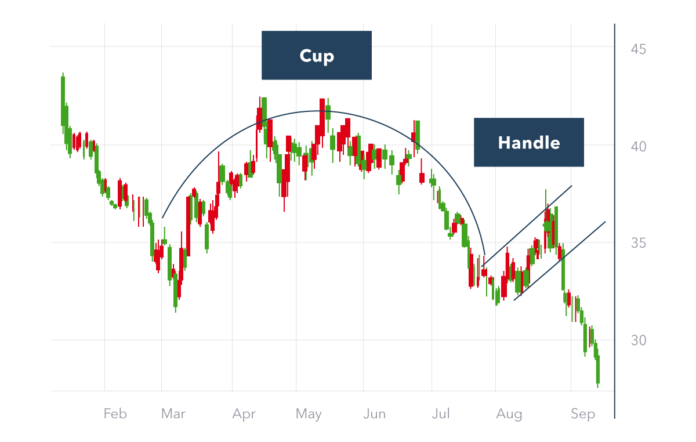The cup and handle pattern is one of the most popular chart patterns in crypto trading. It is easy to identify, but it can be tricky to trade. The pattern consists of two parts: a cup and a handle. The cup represents the bullish trend, while the handle is used to mark the reversal point from bearish to bullish.
In this guide, we will discuss how traders can use this pattern for their own investment decisions in cryptocurrency markets.
What Is a Cup and Handle Pattern?
A Cup and Handle pattern is a technical chart pattern that resembles a cup and handle, where the cup is in the shape of a “U” and the handle has a slight downward drift. This pattern is a bullish continuation pattern, which means that it is usually indicative of an increase in price once the pattern is complete. It can be used as an entry pattern for the continuation of an established bullish trend and is considered one of the easiest patterns to identify.
The cup and handle pattern is a bullish reversal pattern that occurs after an extended downtrend. It consists of two distinct parts:
- The cup, which is a rounded down (and sometimes up) price movement within an established trend.
- The handle, which is a small range between the upper end of the cup and its lower boundary.
Cup and Handle chart pattern is a valuable tool for crypto traders looking to identify potential bullish continuation trends in various trading pairs such as LUNA USDT. By recognizing this pattern in the charts, traders and trading bot can capitalize on the opportunity to enter or add to their long positions, expecting a price increase once the pattern is complete.
Characteristics of the Cup and Handle Pattern
The cup and handle pattern is a continuation pattern. It is a bearish continuation pattern, but it can also be used as a bullish continuation pattern.
This means that if you’re looking to trade this chart formation, you will want to look for price action that confirms your belief in this type of setup. If you think the market will continue going down, then confirmation from lower lows would be required before entering into any trades based on the cup and handle formation’s shape alone (as opposed to other indicators).
Types of Patterns
- Reversal Patterns
- Continuation Patterns
There are many different types of patterns that can be used to identify potential reversals, continuations, or both. Some patterns are more common than others while some are more reliable and profitable than others.
Cup and High Handle
- A cup and high handle pattern is a continuation pattern, meaning that it occurs after an existing trend.
- The cup and high handle can be either bullish or bearish in nature.
- The cup-and-handle pattern is considered to be a reversal pattern because it signals change from one direction to another (a change in trend).
Intraday Cup and Handle
The Cup and Handle chart pattern is a continuation pattern that forms after a decline. It’s formed on an uptrend, so you will often see this pattern after a bullish trend.
When looking at a daily chart, you may notice that there are two distinct parts:
- A downward price movement followed by
- A sideways movement or consolidation area (the cup), followed by another upward move (the handle).
Inverted Cup and Handle Pattern
The inverted cup and handle pattern is the opposite of the regular cup and handle pattern. It is a bearish reversal pattern that indicates that a downward trend is likely to continue. The inverted cup and handle pattern consists of two distinct parts:
- An “inverted” cup shape (a relatively long decline followed by a sharp rise).
- A “handle,” which forms as price consolidates between support and resistance levels before resuming its downtrend.
How To Identify the Cup and Handle Pattern
The first step to identify the cup and handle pattern is to first identify the trend. The trend can be identified by plotting two or more price points on a chart and observing their movement.
Once you have found your current trend, you need to look for support levels, resistance levels and breakouts from these areas. Support represents price points where buyers come in when prices fall below them while resistance represents price points where sellers come in when prices rise above them.
Once these areas have been identified then find out what happens at these levels by looking at previous highs/lows as well as any other indicators such as moving averages etc.
How To Use the Cup and Handle Pattern
Once you have identified a cup and handle pattern, you can use it to predict future price movements. Here are some tips on how to use the pattern:
- Wait for the pattern to complete before taking any action. This means waiting until there is no doubt that there will be a breakout from the cup when it completes, which may take weeks or even months depending on how large your timeframe is and how long it took for the formation of this pattern in question. If after an extended period of time nothing has happened with your trade (i.e., if it hasn’t broken out), then consider closing out your position and moving onto another one or simply letting go altogether because it’s unlikely that anything significant will occur anytime soon–or ever again.
- Set stop losses just outside of both sides of your entry point so that if something goes wrong during execution (like buying high but selling low) then there won’t be too much damage done overall since we’ve already taken precautions against such occurrences beforehand by setting up our risk management strategy beforehand.
Indicators To Identify the Cup and Handle Pattern
There are many indicators that can be used to identify the cup and handle patterns. Some of them include:
- SMA (Simple Moving Average)
- EMA (Exponential Moving Average)
- RSI (Relative Strength Index)
- MACD (Moving Average Convergence Divergence)
If you want to trade this strategy successfully, it’s important that you understand how each of these works so that you know what signals they’re giving off when applied to your chart.
Support and resistance
Support and resistance are two key concepts in trading. They are used to identify areas where the price of an asset is likely to reverse, or change direction.
The idea behind support and resistance levels is that there is a psychological barrier that prevents prices from moving beyond a certain level. If you’re looking at Bitcoin’s chart, for example, you’d notice that each time it approached $4,000–the previous high–there was strong selling pressure which pushed prices back down again until they found support at around $3,800-$4K (the new low).
Trading volume
The trading volume of a crypto asset is another important factor to consider in your analysis. If a cryptocurrency has high trading volume, it’s likely that the price will go higher. Conversely, if the trading volume is low, then we can expect lower prices for that asset. This makes sense because when demand for an asset increases and supply does not increase at the same rate, this creates upward pressure on its price (i.e., more people want it).
Moving average on the trading volume
Moving average on the trading volume is an excellent tool for identifying trends in the market. Moving averages are used to determine the trend direction and they’re also good tools for determining support and resistance levels.
For example, if you have a moving average that crosses below another one, it means that there is more selling than buying pressure on your cryptocurrency pair. This can be seen as a bearish sign because it shows us that traders are losing confidence in their investments since they want to sell their coins as soon as possible before prices drop further down (or even go bankrupt).
Trend lines
Trend lines are one of the most basic chart patterns, and they’re also one of the most useful. They can be used to identify support and resistance levels as well as determine where to place your stop loss order in order to ensure a profit when you’re trading crypto assets.
If you’re not familiar with trend lines, here’s how they work: If a stock or cryptocurrency has been rising steadily over time and then suddenly drops (or vice versa), this indicates that there’s some kind of resistance level at play.
Conclusion
In conclusion, the Cup and Handle chart pattern is a valuable tool for crypto traders looking to identify potential bullish continuation trends. By recognizing this pattern in the charts, traders can capitalize on the opportunity to enter or add to their long positions, expecting a price increase once the pattern is complete.
Write and Win: Participate in Creative writing Contest & International Essay Contest and win fabulous prizes.
















